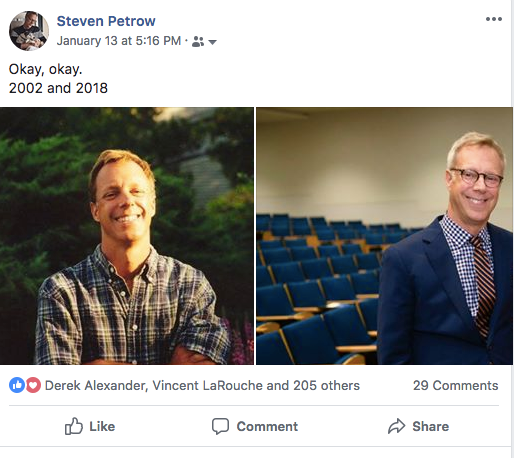Earlier this month out of nowhere came the “How Hard Did Aging Hit You Challenge” that flooded Instagram and Facebook. The game, better known as the “10-Year Challenge,” couldn’t have been easier: Simply post two photos side by side — an early profile photo from 2009 next to a recent one — as proof positive of how you’ve aged. Or, in many cases, miraculously not aged.
It was fun to watch, especially considering how good many of my friends looked. I posted on their feeds. “Ageless!” “Gorgeous X2.” And, “Which is which?” The whole exercise seemed harmless, if a bit self-involved, despite some concerns about privacy. But as the photos and comments continued to pour in, the challenge soon became a barometer of our views about aging, of how we define beauty, even of what it means to live a purposeful life.

CreditSteven Petrow’s “10-Year Challenge” Facebook page.
Somewhat reluctantly, I gave in and posted my then-and-now photos with the caption: “Okay, okay.” The feedback was fast and fine. “Hunky then, and more so NOW!” “U haven’t aged at all.” “You are positively ageless, not to mention ultra handsome.” “You wear glasses now. That’s the only difference I can see.”
I didn’t mind the white lies, but I also felt like something of an impostor. Nothing in my post mentioned my Botox injections, my regular use of Retin-A and vitamin C serum. Nor did it note the major life transitions I’d navigated in the past decade: the deaths of my parents, a divorce, the passing of my cocker spaniel, my sister’s cancer diagnosis.
Kevin LaBar, associate director at Duke University’s Center for Cognitive Neuroscience, said that two opposing forces might be at play in motivating someone to join the challenge. One he called “age defying.” Positive call outs would appeal to a person’s “pure vanity, with a superficial, narcissistic, ageist bent.” The other he called “celebrating aging,” or embracing an older self, wrinkles be damned. For those people, comments like “older and wiser” might resonate most.
Not surprisingly, actors’ challenge photos got a good bit of media attention, with most falling into the “age defying” bucket. Reese Witherspoon uploaded two striking head shots — then and now — and wrote: “Time sure does fly by when you’re having fun!” Most of her Twitter followers responded along the lines of: “You actually got younger. What a vision.”
Amy Gorely, a director at Carolina Meadows, a retirement community in Chapel Hill, N.C., who started the “Be Bold, Claim Old” campaign, said such responses reflect the ageist nature of the game. “The challenge is inherently based on the societal belief that youth is the gold standard. If we look as youthful or — gasp! — better than we did 10 years ago, then society bestows value and we are ‘successfully aging,’” she wrote in an email. “If we do not look as good, then we failed or were hit hard.”
Padma Lakshmi, the host of “Top Chef,” wore a tiny two-piece in her current photo, set against a “before” photo that was 20 years old. The vast majority of the comments on her photos praised her “natural beauty.” But then came the naysayers: “That don’t even look like the same person with her eyes lips and cheeks done,” noted joshuatrophywife. Another poster quoted Vivienne Lewis, a clinical psychologist who specializes in body image: “The message seems to be: women are rising up to be strong, fearless, and vibrant — we are here for the long haul! But you’ll never see us age.”
Dr. Lewis told me she worries that “comparing your life now to how it was 10 years ago can leave a person feeling hopeless, helpless, depressed and anxious.” I hadn’t really thought about those people who weren’t posting: those who might have struggled with illness, divorce, or the death of a spouse or a child, or who don’t like how they’ve aged (weight gain, thinning hair, wrinkles, saggy skin).
But Dr. Lewis also sees an upside: “For those who perceive it as an opportunity to showcase personal growth or enduring social relationships, it can foster an enhanced sense of well-being that can positively contribute to the collective wisdom that accompanies aging.”
Still, most of the criticism of the challenge goes back to its ageism. Dr. LaBar is especially concerned about the impact of the challenge on older adults, whom he says are “particularly susceptible to the impact of negative implicit biases” of ageist attitudes. He explained that “in older adults, performance on memory tests and other cognitively-demanding tasks is impaired after participants had been given verbal reminders of negative aging stereotypes, like older adults are generally slow’ and ‘older adults tend to be forgetful.’”
But Dr. LaBar wasn’t ready to write the challenge off. He told me that some people who have “owned” this challenge have used it to mark major life transitions” — beating cancer, surviving a trauma, graduating from college. “In these cases, the challenge is used as a means of self-actualization, self-affirmation and pride, which is extremely powerful.”
Maybe in joining the challenge I was “celebrating” my age rather than “defying” it. Yes, my skin is dryer, my hair thinner and my cheeks succumbing to gravity. Under the hood my cholesterol is higher, as is my calcium level, an indicator of heart attack risk. My heart has also been battered by loss and sorrow, which reminds me of Elaine Stritch singing “I’m Still Here.”
“I got through all of last year
And I’m here.
Lord knows, at least I was there,
And I’m here!
Look who’s here!
I’m still here!”
That’s the caption I should have written: “I’m still here!”
Steven Petrow, a Hillsborough, N.C., writer, is a regular contributor to Well.

